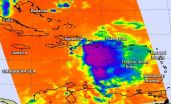(Press-News.org) PITTSBURGH, Aug. 31, 2015 -- People with hostile personality traits who watch more television than their peers may be at a greater risk for injury, potentially because they are more susceptible to the influence of television on violence and risk-taking behaviors, a University of Pittsburgh Graduate School of Public Health analysis discovered.
The research, published online in the International Journal of Injury Control and Safety Promotion, suggests that a reduction in television viewing and content rating systems geared not just to age, but also personality traits, may reduce injury risk.
"Television viewing is very pervasive, with televisions in almost 99 percent of American households. And injuries cause more than half the deaths among people ages 1 through 44. This means that even modest reductions in television viewing, particularly among people predisposed to hostility, could have major positive outcomes for public health," said lead author Anthony Fabio, Ph.D., M.P.H., assistant professor of epidemiology at Pitt Public Health.
Dr. Fabio and his colleagues analyzed data from 4,196 adults recruited from Birmingham, Ala., Chicago, Minneapolis, and Oakland, Calif., who participated in the Coronary Artery Risk Development in Young Adults (CARDIA) Study. For 15 years starting in 1990, the participants periodically reported their television viewing habits and completed in-depth questionnaires to assess their personality traits. The researchers also recorded all injuries requiring hospitalization.
As the amount of television viewing increased, so did the risk of injuries in the next five years. Notably, this relationship risk was greater for those in the "high hostility" group, which was determined by a scientific questionnaire. For example, for high-hostile individuals, watching more TV at year five was associated with 40 percent higher odds of injury at year 10. Additionally, watching more TV at year 15 was associated with a doubling in the odds of injury at year 20. This association did not occur in individuals with less hostile personalities.
Dr. Fabio and his team point to several research-backed explanations for why increased television watching may be responsible for such a pronounced increase in injuries among people predisposed to hostility, including that:
People often imitate new behaviors that they witness, leading them to participate in more high-risk behaviors if they watch more television.
Media violence and high-risk activities increase psychological arousal, intensifying subsequent behavior, such as aggressive risk-taking or impulsivity.
Images on television may desensitize people to violence or risk-taking.
"Prevention programs should target both the content of television programs and the amount of time people spend watching television," said Dr. Fabio. "In addition, future studies should be conducted to determine the impact of modifying television viewing habits, particularly in relation to the personality traits of viewers."
INFORMATION:
Additional authors on this research are Chung-Yu Chen and Karen Matthews, Ph.D., of Pitt; Stephen Dearwater, M.S., of Jackson Memorial Hospital; David Jacobs, Ph.D., Darin Erickson, Ph.D., and Mark Pereira, Ph.D., of the University of Minnesota School of Public Health; Carlos Iribarren, M.D., Ph.D., and Stephen Sidney, M.D., M.P.H., of Kaiser Permanente Northern California.
This research was funded in part by research grants from the National Institute on Aging (NIA) (R03AG028504) and the Centers for Disease Control and Prevention (U49-CE000764). The CARDIA study is supported by contracts HHSN268201300025C, HHSN268201300026C, HHSN268201300027C, HHSN268201300028C, HHSN268201300029C and HHSN268200900041C from the National Heart, Lung, and Blood Institute (NHLBI), the Intramural Research Program of the NIA, and an intra-agency agreement between NIA and NHLBI (AG0005).
About the University of Pittsburgh Graduate School of Public Health
The University of Pittsburgh Graduate School of Public Health, founded in 1948 and now one of the top-ranked schools of public health in the United States, conducts research on public health and medical care that improves the lives of millions of people around the world. Pitt Public Health is a leader in devising new methods to prevent and treat cardiovascular diseases, HIV/AIDS, cancer and other important public health problems. For more information about Pitt Public Health, visit the school's Web site at http://www.publichealth.pitt.edu.
http://www.upmc.com/media
Life on an island isn't always easy. To make the most of the little there is to eat on many Greek islands, the digestive system of Balkan green lizards has evolved considerably compared to family members on the mainland. Surprisingly, many of these insect-eating lizards even have special valves that help to digest plants. These are some of the findings¹ from a study led by Konstantinos Sagonas of the National and Kapodistrian University of Athens in Greece, published in Springer's journal The Science of Nature².
Reptiles can adjust their digestive system and ...
PITTSBURGH, Aug. 31, 2015 -- The more hours young adults spend watching television each day, the greater the likelihood that they'll have a higher body mass index and bigger waist circumference, a 15-year analysis by the University of Pittsburgh Graduate School of Public Health revealed.
The association did not hold in later years, indicating that young adulthood is an important time to intervene and promote less television viewing, according to the research published online in the journal SAGE Open.
"We were quite surprised to find that television viewing was associated ...
ROCHESTER Minn. -- A team of Mayo Clinic Cancer Center scientists has been awarded a Specialized Program of Research Excellence (SPORE) grant in multiple myeloma from the National Cancer Institute. The Mayo Clinic Cancer Center is one of only three cancer centers to receive a SPORE grant for multiple myeloma cancer research.
MULTIMEDIA ALERT: Video and audio are available for download on the Mayo Clinic News Network.
"With project leaders from Mayo campuses in Arizona, Rochester and Florida, our SPORE team will study the genetic basis for myeloma, develop novel viral ...
Satellite data from NOAA's GOES-East satellite was made into an animation that showed the demise of former Tropical Storm Erika as it neared eastern Cuba early on August 29.
At NASA's Goddard Space Flight Center in Greenbelt, Maryland, NASA/NOAA's GOES Project compiled three days' worth of imagery from NOAA's GOES-East satellite that showed the movement and changes in former Tropical Storm Erika from August 27 to August 29. The animation showed Erika move through the Leeward Islands and into the Eastern Caribbean Sea, as its center passed just south of Puerto Rico, then ...
London, UK - 30 Aug 2015: Recruitment of leukocytes is a hallmark of stent thrombosis, according to results from the PRESTIGE study presented today at ESC Congress1 and published in European Heart Journal.2 The findings suggest that immune cell mediated thrombotic processes may be a realistic target for novel therapies to prevent stent thrombosis.
"Stent thrombosis (ST) is a life-threatening complication of percutaneous coronary intervention and recent large scale clinical registries reported an incidence of up to 0.4-0.6% per year," said principal investigator Professor ...
How did the ankylosaur get its tail club? According to research from North Carolina State University and the North Carolina Museum of Natural Sciences that traces the evolution of the ankylosaur's distinctive tail, the handle arrived first on the scene, and the knot at the end of the tail followed.
The typical ankylosaur had a wide armored body and a flexible tail. But one group of ankylosaurs - ankylosaurids - also had a tail club that could have served as a useful weapon. These "weaponized" ankylosaurids lived about 66 million years ago, during the Cretaceous period. ...
LONDON (Aug. 31, 2015) -- Cardiologists failed to identify more than half of basic and about 35 percent of advanced pre-recorded murmurs, but skills improved after a 90 minute training session, according to research presented today at the European Society of Cardiology Congress 2015.
Recent breakthroughs in the transcatheter treatment of aortic and mitral valve disorders provide new therapies for patients, but physicians must be able to detect valve problems in a timely manner for patients to see the full benefit of these advances, said Michael Barrett, MD, the lead ...
London, UK - 31 Aug 2015: A gene associated with sudden cardiac death in the general population has been identified using implantable cardioverter defibrillator (ICD) monitoring in research presented for the first time at ESC Congress today.1 The research included patients from the DISCOVERY trial and Oregon-SUDS and discovered that a polymorphism in the GNAS gene predicted ventricular tachyarrhythmias and sudden cardiac death.
"This is the first time a gene has been identified using ICD monitoring and then confirmed to be associated with sudden cardiac death in the general ...
LONDON, UK - 30 August, 2015: In patients with type 2 diabetes and acute coronary syndrome, the glucose-lowering medication lixisenatide did not increase or decrease the rate of cardiovascular (CV) events compared to placebo, according to results of the Evaluation of Lixisenatide in Acute Coronary Syndrome (ELIXA) trial.
The study, presented today at ESC Congress 2015, "demonstrates the cardiovascular safety of lixisenatide", reported Eldrin F. Lewis, MD, MPH, a member of the ELIXA trial's executive committee, a physician in the Cardiovascular Medicine Division at Brigham ...
LONDON, UK - 30 August, 2015: Patients with type-2 diabetes and cardiovascular disease can safely take the antihyperglycemic drug sitagliptin without an increased risk of cardiovascular complications - even if they have a history of heart failure - a new analysis of the TECOS (Trial Evaluating Cardiovascular Outcomes with Sitagliptin) study shows.
The findings, presented today at ESC Congress 2015, "provide reassurance to patients and prescribers about the cardiovascular safety of sitagliptin" - a dipeptidyl peptidase-4 (DPP-4) inhibitor sitagliptin - according to Paul ...


